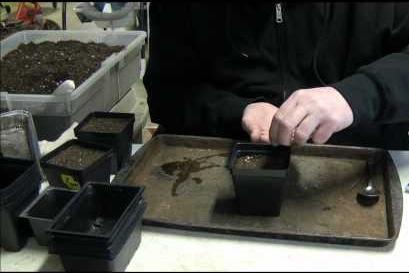Often, beginning flower growers and simply the owners of personal plots ask themselves this question: “What would you plant such that it was beautiful and it’s not troublesome to take care of?” In this case, it's time to remember such a familiar and unpretentious plant as rudbeckia (Rudbeckia). There are a lot of reasons to plant it: bright flowers, beautiful greenery, long-term preservation of decorativeness (even in the absence of flowering), frost and drought resistance, photophilousness. There are one-, two- and perennial varieties, as well as low and tall rudbeckia. Growing from seeds, cuttings, dividing a bush - these are the main ways of planting this flower. Currently, low-growing varieties (10-15 cm) are bred, but basically it is a rather tall plant (some grow up to 2.5 m, for example, split-leaf rudbeckia).

Growing from the seeds of this plant is possible, but they need to be sown in seedlings or a hotbed, the best time for this is the beginning of April. Some varieties of rudbeckia breed perfectly self-seeding, however, in this case, they can ascend anywhere, and then they will have to be transplanted to the right place. Breeders have done enough to improve this plant. Coloring of flowers is one-color or multi-color, and the flowers themselves can be simple or double. Sometimes one does not even believe that this is the same
rudbeckia flower. Growing from seeds gives good results, subject to several simple planting rules.
1. Sowing should be done in early April.
2. The temperature should not be lower than 16 ° C, it is better to shed the soil before planting the seeds with boiling water. This will warm the ground and will be an additional disinfection of the soil.
3. Shoots will appear on day 9 or a little earlier.
4. Plants can be transplanted to a permanent place (the distance between the bushes should be 30-50 cm), after a constant temperature is established and there are no frosts.
Important:
a) If the variety is tall, it is better to make the distance between plants up to 1 m.
b) When sown directly in the greenhouse, seedlings can simply be thinned out.
c) Before planting, pots with seedlings must be taken outside in warm and calm weather or open a greenhouse. Tempering time gradually increase.
Caring for adult plants does not present any difficulty: loosening the soil, watering and applying fertilizers. It is better to choose a sunny place for planting, but the shadow is also suitable, only flowering in this case will not be so plentiful, the height of the bush is small. Tall varieties are often used to decorate fences and outbuildings, medium-sized bushes look great on flower beds and pots, and low-growing ones are suitable for edging paths.
Among the variety of species of rudbeckia, the most popular are rudbeckia hairy (Rudbeckia hirta) and rudbeckia purpurea (Rudbeckia purpurea). Although the second would be more correct to call Echinacea (Echinacea).
Rudbeckia hairy - an annual plant, blooms in the year of planting. The color of the petals varies from lemon yellow to orange brown, the core is dark or greenish. The height of the bush is up to 90 cm, the inflorescences are quite large (may be more than 8 cm). In winter, the plant freezes, but its seeds winter and germinate in spring.
Rudbeckia purpurea, or echinacea, is a perennial tall plant (up to 1 m). Inflorescences are large, purple in color, can be simple baskets or terry. Adult plants are not afraid of frost, and young ones are better to shelter for the winter.
So, the solution to the problem with what to plant can be an overseas guest rudbeckia. Growing from seeds or propagating in another way - you choose.